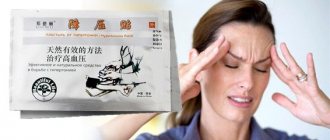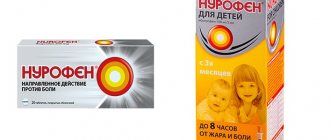Ibuprofen is rightfully considered the most effective and common remedy for treating the symptoms of colds and acute respiratory viral infections. Some patients successfully relieve fever with its help and consider it an antipyretic, while others relieve serious pain of a chronic nature, for example, in the spine. The fact is that Ibuprofen has three properties at the same time: anti-inflammatory, analgesic and antipyretic.
Ibuprofen
Indications for use
Ibuprofen belongs to the group of non-steroidal anti-inflammatory drugs (NSAIDs) - derivatives of phenylpropionic acid. In the instructions for tablets and capsules for adults, we see primarily prescriptions related to the symptomatic treatment of diseases of the joints or spine (rheumatoid arthritis, osteoarthritis, bursitis, sciatica), the fight against pain from injuries, myalgia and neuritis. In children's forms, we find the following indications: sore throat, pain with otitis media, teething, reduction of fever during ARVI or influenza, relief of symptoms of fever during childhood infections and post-vaccination reactions.
Of course, the indications are not limited to those mentioned above. We list here the most common types of pathologies where Ibuprofen does an excellent job eliminating inflammation and pain:
- Pathologies of the musculoskeletal system, pain relief: ankylosing spondylitis, radiculitis, spinal osteochondrosis, exacerbation of gout, polyarthrosis, psoriatic arthritis, tendinitis, inflammation of soft tissues in injuries, back pain, joint pain, trauma, sprains, dislocations, myalgia of various types .
- Diseases of the peripheral nervous system: neuralgia and neuritis.
- Gynecology: primary dysmenorrhea, secondary dysmenorrhea, pain during painful menstruation, with adnexitis.
- Relief of various types of pain: toothache, headache, migraine, sore throat, ear pain with otitis media, muscle pain.
- Use as an antipyretic for fever, flu, ARVI and colds. Increased temperature in infectious and inflammatory diseases.
- Relief after vaccination, including against coronavirus.
Safety of ibuprofen in clinical practice
B
ol is the body’s main reaction to any tissue damage, so its relief is a problem for doctors of any specialty.
According to modern ideas about the mechanisms of development and transmission of the pain signal, a comprehensive approach using various groups of pharmacological agents is considered a reasonable treatment for pain, the mechanism of action of which is primarily aimed at suppressing the synthesis of inflammatory mediators and limiting the flow of nociceptive information from the periphery to the central nervous system.
Analgesics are widely used throughout the world. In England, more than 20 million people receive prescriptions for non-steroidal anti-inflammatory drugs (NSAIDs), and in one year (1999–2000) more than 100 million prescriptions were written for COX-2 inhibitors [18].
NSAIDs are most in demand primarily in rheumatic diseases for the relief of articular syndrome, in trauma, postoperative conditions, renal colic, migraine, dysmenorrhea, neurological diseases, and recently their preventive effect in colon cancer and Alzheimer's disease has been discussed. According to a survey conducted in Western European countries, NSAIDs are prescribed by more than 80% of general practitioners
[5,18].
The leading place in sales is occupied by over-the-counter analgesics, which are used as antipyretics and pain relievers of various origins: headaches, dental pain, dysmenorrhea, etc.
In 1998, 16.1 billion over-the-counter NSAIDs were sold in the United States, compared with 2.9 billion prescription ones. Of particular concern is the violation of the drug dosage regimen (about 1/3 of patients take prescription NSAIDs in larger doses than recommended by the doctor).
Given the predicted “aging” of the planet, the number of people needing to take NSAIDs will steadily increase. This poses a challenge for physicians to ensure the safety of NSAID treatment. In the United States, more people die each year from medical errors than from street injuries, lung cancer, and AIDS [22]. One of the reasons for this is ignorance of the mechanism of action of drugs, especially when used in combination, and possible adverse reactions.
Currently, the issue of safety of NSAIDs comes first. Possible side effects when using NSAIDs include damage to the gastrointestinal tract, impaired platelet aggregation, renal function, and a negative effect on the cardiovascular system. Gastrointestinal disorders are the most common side effects with NSAID use. Among the frequently used NSAIDs, we can highlight drugs that are particularly unfavorable in this regard - indomethacin, piroxicam, flurbiprofen; relatively safe drugs are ibuprofen, diclofenac, ketoprofen, as well as selective COX-2 inhibitors [4,9].
A number of researchers explain the clinical effect and the development of adverse reactions by the half-life of NSAIDs, with the more dangerous of them being long-lived ones (Table 1).
The development of side effects is often dose-dependent, as shown in Table 2, from which it follows that the analgesic dose of ibuprofen (1200 mg/day) is as safe as placebo. The main mechanism determining the safety of the drug is its ability to suppress the activity of cyclooxygenase-2 (Table 3). However, a direct relationship between the anti-inflammatory and analgesic effect and the severity of COX-2 inhibition was not identified. The most common side effects caused by inhibition of COX-1 and 5-lipoxygenase [19] are gastrointestinal damage, renal dysfunction, platelet aggregation, etc. (Table 4). It is believed that gastrointestinal side effects are one of the most common adverse events when using NSAIDs [27]. However, there was a clear dose dependence of the risk of developing NSAID gastropathy [14,16] (Table 5). A dose of ibuprofen 1200 mg/day is regarded as one of the safest in relation to gastrointestinal complications.
OTC NSAIDs are especially often used not only as analgesics, but also as antipyretics, competing with acetaminophen. A comparison of the effect of 400 mg of ibuprofen and 1000 mg of acetaminophen in the treatment of 113 patients with sore throat caused by tonsillitis-pharyngitis [10] showed that ibuprofen was significantly more effective, especially during the first 6 hours. With short-term use of these drugs, tolerability was equal.
A randomized trial of 3 analgesics: acetylsalicylic acid (ASA), acetaminophen, and ibuprofen was conducted in France and England with the participation of 1108 general practitioners. The study included 8677 adult patients with pain of musculoskeletal origin, throat, and acute respiratory infections [23]. Treatment was carried out for 1–7 days in doses: ASA and acetaminophen 3 g/day, ibuprofen up to 1.2 g/day. The frequency of significant adverse events when taking ASA was 18.7%, ibuprofen – 13.7%, acetaminophen – 14.5%. The total number of gastrointestinal complications was noted in 5.8% of those treated with ibuprofen, 7.3% with acetaminophen, and 10.6% with ASA. Gastrointestinal bleeding was absent in patients receiving ibuprofen, but was diagnosed in 4 patients on acetaminophen (which does not inhibit COX-1) and in 2 patients on ASA.
In terms of the time of development of gastrointestinal complications, treatment with ASA was the most unfavorable, because they appeared already on the first day after taking 1-2 tablets. Commission conclusion: General practitioners should give preference to ibuprofen over ASA and acetaminophen
due to the poorer tolerability of ASA and the potential for acetaminophen overdose.
The high safety of ibuprofen is also evidenced by the fact that it has been an over-the-counter drug for more than 20 years in the country where it was created in 1962 by S. Adams et al., who worked at Boots (UK) (Fig. 1) .
Rice. 1. Risk of upper gastrointestinal bleeding associated with NSAID use [17]
Undesirable complications include complications from the cardiovascular system, in particular, heart failure, the risk of which is higher in patients with arterial hypertension, heart and kidney diseases (Table 6) [24]. According to the ANA, the frequency of these events when using NSAIDs in patients with hypertension exceeds 25%. The likelihood of developing heart failure is higher when using NSAIDs with a long half-life (piroxicam) than with a short half-life (ibuprofen, diclofenac). The risk of developing heart failure is higher in people over 55 years of age, especially in those taking diuretics. A randomized study of 8059 patients with rheumatoid arthritis and osteoarthritis receiving celecoxib 400 mg/day, ibuprofen 800 mg/day, diclofenac 75 mg/day. showed an equal frequency of cardiovascular complications [1].
A study of the effect of NSAIDs on blood pressure in 1213 hypertensive patients showed that when taking ibuprofen, mean blood pressure decreased by 0.3 mmHg. and increases by 6.1 mm Hg. when taking naproxen [25].
Neither classical NSAIDs nor selective COX-2 inhibitors provide cardioprotection, with the exception of low-dose ASA, which irreversibly inhibits COX-1 activity in platelets. The work [13] showed that taking ibuprofen before ASA can block the inhibition of platelet COX-1 and reduce platelet aggregation caused by ASA, without affecting the level of serum thromboxane B2. This fact should be taken into account when treating patients receiving ASA for the prevention of vascular complications, and its use should be recommended before ibuprofen, because this sequence does not cancel the effect of acetylsalicylic acid.
With the advent of a new class of NSAIDs—selective COX-2 inhibitors—the issue of their analgesic effectiveness compared to classical NSAIDs is being actively discussed [21]. The authors of this review indicate that in the literature, clinical studies of the effectiveness of selective COX-2 inhibitors in the treatment of non-arthritic diseases either give ambiguous results or are absent. Analgesia for postoperative dental pain with rofecoxib at a dose of 50 mg was equal to 400 mg of ibuprofen, and 200 mg of celecoxib was weaker. With regard to acute tonic pain, there is no evidence of equality between these two groups of NSAIDs. The authors believe that to achieve the maximum analgesic effect, inhibition of both COX isoforms is necessary, because There is evidence of a temporal and dynamic relationship between COX-1 and COX-2 and their participation in the formation of Pg E2 and subsequent clinical manifestations of pain [23].
The relative risk of developing edema in clinical practice among hypertensive patients in the United States is presented in Figure 2 [28]. As we see, ibuprofen has a clear advantage over the compared drugs.
Rice. 2. Relative risk of developing edema in clinical practice [31]
The
CLASS
[14], which compared the effect and tolerability of celecoxib and ibuprofen, showed that ibuprofen is inferior to celecoxib in the incidence of edema and increased blood pressure, but is safer than rofecoxib (Fig. 3).
Rice. 3. Hypertension and edema [14]
In rheumatology, NSAIDs are prescribed for almost all diseases, given their triple mechanism of action. In the foreign literature, the algorithm for the treatment of osteoarthritis is widely discussed, in which acetaminophen is placed in first place. A double-blind randomized study conducted [11] showed that in patients with gonarthrosis, the anti-inflammatory dose of ibuprofen was 2.4 g/day. was more effective than analgesic – 1.2 g/day. and 4.0 g/day. acetaminophen, which was confirmed by a decrease in joint pain and improvement in motor function.
An analysis of Medline data on the effect of various analgesics (meloxicam, naproxen, diclofenac, ibuprofen, celecoxib, rofecoxib, codeine, morphine [8]) on the severity of pain in osteoarthritis (OA) showed that the best clinical effect was achieved with the use of ibuprofen, diclofenac and naproxen.
A review [12] on the treatment of OA presents the results of a double-blind study of ibuprofen and benoxyprofen in a 4-week study, indicating a reduction in pain by 21% in both groups. Similar results were obtained when comparing fenoprofen calcium and ibuprofen.
Data [15,26] indicate equal effectiveness for gonarthrosis of ibuprofen at a dose of 1.2–2.4 g/day. and tramadol 200–400 mg/day, which once again confirms the high analgesic effect of ibuprofen.
A common reason for visiting a doctor and an equally common disability is low back pain (LBP), in which the acute phase of pain is usually limited to 7–8 days. NSAIDs are the drugs of choice for the management of this pain [6]. A comparative randomized study in which 48.3% of patients suffered from LBP showed that 1200 mg/day. ibuprofen is equivalent to 3 g of acetaminophen, more effective than 3 g of ASA and safer than ASA and acetaminophen [6].
The analgesic effect of 1200 mg ibuprofen for LBP was confirmed in one study [2], where it was shown that the average pain intensity according to VAS decreased by more than half on the second day, and by the sixth day it completely or significantly decreased in 73% of patients.
In the United States, up to 30% of visits to the doctor are related to fever in children [7]. Ibuprofen is allowed to be used as an antipyretic at a dose of 5–20 mg/kg, which is comparable to the effect of acetaminophen.
Issues of the effectiveness and safety of ibuprofen in pediatric practice are covered in the review of Prof. Geppe HA [3]. Pediatricians consider ibuprofen to be the best-tolerated NSAID in children
. Prof. Antret-Leca [3] concluded: “Compared with acetaminophen and ASA, ibuprofen has less toxicity in overdose and therefore a wider therapeutic range.”
The safety of ibuprofen is evidenced by the fact that it is approved for the treatment of children under 2 years of age. An analysis of treatment (double-blind study) of 84,000 children under 2 years of age for febrile illness with ibuprofen at a dose of 5–10 mg/kg and acetaminophen 12 mg/kg showed that ibuprofen did not increase the risk of hospitalization in children [20].
The presented data indicate that ibuprofen has a high analgesic effect at a dose of up to 1200 mg/day, is well tolerated by adults and children, is used in infants and premature infants, and is not inferior in tolerance to selective COX-2 inhibitors.
Literature:
1. Belousov Yu.B., Gurevich K.G. The effect of NSAIDs and paracetamol on the cardiovascular system. Wedge. pharmacological therapy, 2002, 5, 5–7
2. Vein A.M., Danilov A.B. The effectiveness of solpofex in the treatment of low back pain. Wedge. Pharmacol. Therapy, 1999, 8, 2, 47–78
3. Geppe NA First international conference on the use of ibuprofen in pediatric breast cancer, 2002, t10, no. 18, 831–835
4. Nasonov E.L. NSAIDs for rheumatic diseases: standard of treatment. RMZh, 2001, t9, no. 7–8, 265–270
5. Nasonov E.L. Use of NSAIDs: therapeutic aspects. RMJ, 2002, t10, no. 4, 206–212
6. Nasonova V.A. NSAIDs for acute pain in the lower back. Consilium medicum, 2002, v4, no. 2, 102–106
7. Tabolin V.A., Osmanov I.M., Dlin V.V. The use of antipyretics in childhood. Wedge. pharmak. therapy, 2002, t11, no. 5, 12–14
8. Babul N., Peloso PM Comparative Pharmacologic Response of analgesic agents on key outcome variables in osteoarthritis. X World Congress on Pain, USA, 2002 P 211
9. Biarnason IT The effects on NSAIDs on the small intestine: clinical implications. New Standards in Arthritis Care, 1997, v6, N 2, p2
10. Bourean F., Pelen F., ea Evaluation of Ibuprofen is Paracetamol Analgesic Activity using a Sore Throat Pain Model. Clin. Drug Invest., 1999, 17(1), 1–8
11. Brodley ID, Brandt KD, Kats BP ea Comparison of anti–inflammatory dose of ibuprofen, an analgesic dose of ibuprofen and acetomenofen in the treatment of patients with osteoarthritis. N.Eugl. J. med., 1991, 325, 87–91
12. Brandt KD The role of Analgesics in the Management of OA Pain Amer. J. Therapeutics, 2000, v7 N2, 75–90
13. Catella–Lawson F. E a Cyclooxygenase inhibitors and the Antiplatelet effects of Aspirin. The New Eugr. J.Med., 2001, v345, 25, 1809–17
14. CLASS Advisory Committee Briefing Document FDA Arthritis Advisory Committee Meeting 2001, Maryland, Gaithersburg
15. Dalgin P. Comparison of tramadol HCL and ibuprofen for the chronic pain of OA. Arthr. Rheum., 1997, 40, 586
16. Gabriel SE, Iaakkimainen L. ea Risk for serious gasthrointestinal complications related to use of NSAID. A meta-analysis. Am. Yntern. Med., 1991, 115: 787–796
17. Guthann S., Rodrigues G., Raiford FS Individual NSAIDs and other risk factors for Upper gastrointestinal bleeding and perforation. Epidemiology, 1997, 8, 18–24
18. Hillis WS Areas of Emerging interest in analgesics: cardiovascular complications. Am. J. Therapeutics, 2002, 9, 259–69
19. Laufer S., Tries S. Pharmacological profile of a new pyrrolizine derivative inhibiting the Enzymes COX and 5-lipoxygenase. Arzneim-Forsch Drug Res., 1994, 44: 629–636
20. Lesco SM The safety of acetaminophen and ibuprofen children less than two years old/ Pediatrics, 1999, 104, 4, 1–5
21. McCormack K., Twycross R. Are COX–2 selective inhibitors effective analgesics? Pain Reviews, 2001, 8, 13–26
22. Medical errors in the USA WHO pharmaceuticals Newsletter, 2000, N2, 13–14
23. Moore N. ea The pain study: paracetamol, aspirin, ibuprofen: New tolerance. Clinical Drug Invest., 1999, 18(2), 89–98
24. Page J., Henry D. Development of congestive heart failure in elderly patients: an under recognized public health problem. Arch. Int. Med., 2000, 160, 777–84
25. Pope JE, Anderson II, Felson DTA meta–analysis of the effects of NSAIDs on blood pressure. Arch. Int. Med., 1993, 153, 477–84
26. Reid E. Tramadol in Musculoskeletal Pain—a Survey. Clin. Rheumat., 2002, v21(suppl. 1), 9–12
27. Singh G. Gastrointestinal complications of prescription and over the counter NSAID; A view from the ARAMIS Database. Am. J. of Therapeutics, 2000, 7, 115–121
28. Zhao S. ea Comparison of edema clines associated with rofecoxib, celecoxib, and traditional NSAIDs among stable hypertensive patients in the US insured population. Am. Rheum. Dis., 2002, v 61, suppl 1, p 346
What forms does Ibuprofen come in?
In pharmacies you can find four dosage forms of the drug:
- If there are no contraindications related to the gastrointestinal tract, then people usually choose tablets or capsules.
- In cases where there is a stomach disease in the acute stage or the patient for some reason cannot swallow a tablet, suppositories are prescribed.
- Syrups are prescribed to infants. Most pediatricians prefer to reduce fever using Ibuprofen rather than Paracetamol, since the former acts faster and longer, and also has a lower safety profile due to the absence of toxic metabolites.
- For pain in the joints, muscles, back, and injuries, the ointment is ideal.
Composition and release form
The medicine is available in several forms:
- pills;
- ointment;
- gel;
- candles;
- children's oral suspension.
The active substance is ibuprofen.
Auxiliary components in the tablets: potato starch, magnesium stearate, beeswax, sucrose.
Additional gel ingredients: ethanol, lavender oil, water.
Excipients in the ointment: macrogol.
Additional components of candles: solid fat.
Instructions for taking Ibuprofen for adults and children.
- A single dosage for an adult is 200 mg; in case of severe pain, you can take 400 mg, the dosage frequency is 3-4 times a day, but not more than 1200 mg per day.
- A single dose for a child over 6 years old is 200 mg, can be taken 3-4 times a day. The maximum dosage for children per day differs by age as follows: for children 12-17 years old - 1000 mg; for children aged 6 to 12 years - 800 mg.
Ibuprofen Welfarm for adults
How many days can you take Ibuprofen?
The drug is taken for 2-3 days; if the patient’s condition does not improve or becomes worse, it is necessary to stop taking it and consult a doctor.
Ibuprofen for children
Ibuprofen in the form of syrup for children is used from the age of 3 months and can begin to act within 15 minutes. The tablets take effect within 30 minutes.
How to use baby syrups?
Children's syrups are usually made using fruit fillings and therefore children take them with pleasure. For the little ones there is a measuring syringe complete with syrup, where 1 ml contains a certain dose of Ibuprofen.
It is necessary to follow the manufacturer's instructions, the maximum daily dosage for a child is 30 mg per 1 kg of body weight, the interval between doses is from 6 to 8 hours. As we noted earlier, the duration of treatment should not exceed 3 days. Syrups are popular and therefore they are often designed for use up to 12 years, although tablets can also be used from 6 years.
The dose of syrup for a child can be determined from the table.
| Child's age | Body weight in kg | Dosage | Maximum dose per day |
| 3-6 months | 5kg-7.6kg | 50 mg up to 3 times a day | 150 mg |
| 6-12 months | 7.7-9 kg | 50 mg up to 3-4 times a day | 200 mg |
| 1-3 years | 10-16 kg | 100 mg up to 3 times a day | 300 mg |
| 4-6 years | 17-20 kg | 150 mg up to 3 times a day | 450 mg |
results
- The analysis showed that celecoxib reduced mean 24-hour systolic blood pressure by -0.3 mmHg. Art., while ibuprofen and naproxen increased by 3.7 and 1.6 mmHg. Art., respectively. The difference between celecoxib and ibuprofen was statistically significant (p=0.009).
- Additional analysis demonstrated that the percentage of patients with normal BP at baseline who were subsequently diagnosed with hypertension was 23.2 in the ibuprofen group, 19.0 in the naproxen group, and 10.3 in the celecoxib group (odds ratio, 0.39; p =0.004 for celecoxib ibuprofen and 0.49 p=0.03 for celecoxib vs. naproxen).
Ibuprofen ointment 5%
The drug is widely used as an external agent. Ointments and gels are produced in pure form or with the addition of cooling agents.
The ointment helps with arthritis, sprains, pain from damaged ligaments, back pain, sports injuries, and neuralgia.
How to use Ibuprofen ointment?
Usually the ointment is prescribed to adults and children over 14 years of age.
The dosage depends on the manufacturing company. A gel from 4 to 10 cm approximately contains 50 – 125 mg of the drug and this is a single dose. The product should be gently rubbed into the skin. Reapply no earlier than after 4 hours. The maximum daily dose is 500 mg.
Ibuprofen ointment
When to take medicine
The medicine in tablet form is effective for the following conditions:
- inflammatory processes in the spine and joints;
- moderate pain of various origins (menstrual, headache, toothache, pain after surgery);
- fever caused by a cold infection.
Gel and ointment should be used in the following cases: osteoarthritis, arthritis, gout and other diseases of the musculoskeletal system.
Suppositories and syrup are usually prescribed to children to reduce body temperature, for various childhood infections and to reduce pain (in the head, throat, ear).
Side effect
- Like all medications, Ibuprofen can cause allergic reactions: skin itching, urticaria, Quincke's edema, anaphylactic reactions, incl. anaphylactic shock. In this case, you should stop taking the drug and consult a doctor.
- The following side effects may be observed on the part of the digestive system: pancreatitis, nausea, vomiting, erosive and ulcerative lesions of the gastrointestinal tract, stomach and abdominal pain, stomatitis, liver dysfunction, hepatitis.
- Genitourinary system: polyuria, renal dysfunction, renal failure, edema, cystitis, nephrotic syndrome, interstitial nephritis.
- Nervous system and sensory organs: irritation and dry eyes, ringing in the ears, hallucinations, psychomotor agitation, confusion, headaches, anxiety, irritability.
- Respiratory system: allergic rhinitis, bronchospasm, shortness of breath.
- Cardiovascular system: agranulocytosis, leukopenia, increased pulse, hypertension, heart failure.
Contraindications:
- Hypersensitivity to the components of the drug.
- Bleeding disorders, hemophilia.
- Hematopoietic disorders.
- Erosive and ulcerative lesions of the gastrointestinal tract in the acute stage, bleeding in the gastrointestinal tract.
- Kidney or liver failure.
- Severe heart failure.
- The period after coronary artery bypass surgery.
- “Aspirin triad” (aspirin intolerance, nasal polyps and bronchial asthma).
- Diseases of the optic nerve.
- Caution should be exercised when taking other NSAIDs.
- Simultaneous use of medication and alcoholic beverages is not recommended.
special instructions
- Ibuprofen is prescribed in a short course - three days. If therapy lasts 10 days or more, you should consult a doctor.
- Elderly patients need to carefully monitor the tolerability of the drug, as they are more likely to experience side effects.
- May temporarily reduce female reproductive function (the effect disappears after discontinuation).
- It may affect the ability to drive vehicles, so if the patient notices lethargy or drowsiness, he should refrain from driving vehicles and other activities where reaction speed is required.
Ibuprofen for children
Interaction with other drugs
Ibuprofen was created back in 1953 and is therefore well studied. Here we will briefly list its interactions with common drugs - this is mainly a group of cardiovascular drugs, some antibiotics. A complete list of drug interactions should be read in the instructions for the drug.
- Reduces the effect of ACE inhibitors, beta-blockers and some diuretics, such as furosemide.
- The effect may be enhanced when taken with anticoagulants.
- The activity of amlodipine decreases.
- Caution should be used when taking warfarin, methotrexate and lithium together.
- Interactions have been noted with cardiac glycosides, quinolone antibiotics, ethanol, barbiturates, rifampicin, phenylbutazone, cyclosporine, mifepristone, tacrolimus, zidovudine, cefoperazone, cefotetan, valproic acid.
Discussion
The principal investigator, Prof Ruschitzka (Switzerland, Zurich) noted that the increase in cardiovascular risk during NSAID therapy is in particular associated with drug-mediated increases in blood pressure. This position challenges the well-known hypothesis that the adverse cardiovascular effects of NSAIDs are directly related to effects on platelets and endothelial cells.
It is important to remember that the decrease in systolic blood pressure is only 2 mmHg. Art. is associated with a 10% reduction in mortality from stroke and a 7% reduction in mortality from coronary heart disease.
Source:
European Society of Cardiology Congress. August 28, 2021.








